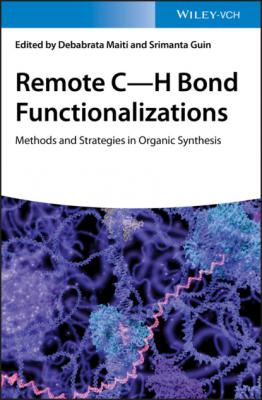Remote C-H Bond Functionalizations. Группа авторов
Читать онлайн.| Название | Remote C-H Bond Functionalizations |
|---|---|
| Автор произведения | Группа авторов |
| Жанр | Химия |
| Серия | |
| Издательство | Химия |
| Год выпуска | 0 |
| isbn | 9783527824144 |
ortho‐C–H functionalization has been usually promoted by σ‐chelation of the directing template. However, applying this chelation to meta‐C–H functionalization is much more challenging since a strained cyclophane‐like metallacycle might be involved in this transformation [11]. In 2012, the group of Yu and coworkers disclosed the first geometry‐induced remote meta‐C–H activation of toluenes and hydrocinnamic acids with a Pd(II) catalyst, which is assisted by two types of rationally designed nitrile‐based templates that are covalently linked with toluenes or hydrocinnamic acids through an ether or amide bond (Scheme 2.1b) [11]. The presumable linear coordination mode of the nitrile‐based chelating functionality (CF) in the U‐shaped template that weakly coordinates to the palladium center in an end‐on fashion is important for securing a possible less strained cyclophane‐like pre‐transition state. However, a more likely catalytic scenario is the weakly chelating template may “catch and release” the Pd(II) catalyst closely to the target meta‐C
Scheme 2.1 Directing template assisted meta‐C
(a) Li et al. [5], Yang [6], Chattopadhyay and Bisht [7], Dey et al. [8], Ghosh and De Sarkar [9], and Dey et al. [10]; Source: (b) Modified from Leow et al. [11].
Inspired by this pioneering work, a series of directing template assisted remote meta‐C–H activation reactions have been realized for a list of substrates including acids, amines, sulfonic acids, and so on (Scheme 2.1c). Notably, one of the key features of these reactions is the target C
Herein, we summarize important achievements that were disclosed until October 2019 in the field of directing template assisted meta‐C–H functionalization of arenes with Pd or Rh catalysts since 2012. Different aspects of this type of methodology will be covered while discussing the works that are categorized by the substrate type. Important mechanistic studies on this methodology will also be included. It is hoped that the reader will learn the key points, especially structural features, for rationally designing a feasible template for new substrates as well as developing new types of meta‐C–H transformation after reading this chapter.
Scheme 2.2 Three categories of chelating functionality (CF). (a) N‐Based CN‐containing CF; (b) N‐based heteroarene‐containing CF; (c) O‐based CO2H‐containing CF.
2.2 Template‐Assisted meta‐C–H Functionalization
2.2.1 Toluene Derivatives
In 2012, Yu and coworkers devised the first effective U‐shaped nitrile‐based directing template that was covalently linked to the toluene derivatives via a removable benzyl ether linkage (Scheme 2.3) [11]. Notably, the directing ability of the template was improved by installing two isobutyl templates at the α‐position adjacent to the linearly chelating nitrile template due to the Thorpe–Ingold effect. This directing template efficiently enabled the meta‐C–H olefination of a broad range of toluene derivatives using Pd(OPiv)2 as the catalyst and AgOPiv as the oxidant. It is worth mentioning that such remote C–H activation that possibly demanded a cyclophane‐like 11‐membered palladacycle was first ever disclosed. Remarkably, the intrinsic electronic and steric biases of the substrates were successfully overridden. Finally, the directing template was readily cleaved through hydrogenolysis with a Pd/C catalyst.
Scheme 2.3 meta‐C–H activation of toluene derivatives.
Source: Modified from Leow et al. [11].
2.2.2 Acid Derivatives
2.2.2.1 Hydrocinnamic Acid Derivatives
In Yu's seminal report, meta‐C–H olefination of hydrocinnamic acid derivatives was also achieved using an easily synthesized and recyclable 2,2′‐azanediyldibenzonitrile directing template, which is now available from Sigma–Aldrich as the Yu–Li auxiliary [11]. This template was attached to several hydrocinnamic acids via a readily cleavable amide linkage (Scheme 2.4).
